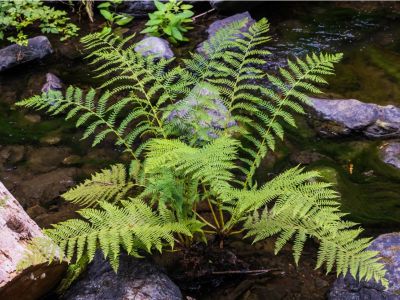Lady Ferns in the Garden
Locating lady fern plants may require observation of the spot before planting. Lady ferns in the woodland garden do best in a lightly shaded spot or an area that gets dappled sunlight year-round. Plant them in a loamy soil that is slightly on the acidic side, amended with shredded oak leaves or other organic material that is well composted. Soil should be well-draining so that roots do not rot. Poultry grit may also be worked in to improve drainage. Planting lady ferns in the right place allows them to colonize and provide an attractive groundcover. Choose the proper cultivar for your area too. Athyrium filix-femina angustum (Northern lady fern) performs best in the upper United States, while Southern lady fern (Athyrium filix-femina asplenioides) takes the extreme summer heat of the south. Both have upright arching fronds that may reach 24 to 48 inches (61-122 cm.). More than 300 cultivars of lady fern plants are available commercially as well.
How to Grow a Lady Fern
Ferns may be propagated from spores, called sori and indusia, that grow on the back of the leaves. Starting ferns from spores can be a time-consuming process, so start your lady fern plants from division of the rhizomes or by purchasing small plants. Divide lady ferns in the garden in spring. Then plant your lady ferns in the shady location where the soil has been amended, if necessary. Water regularly when planting lady ferns in a new spot. Once established, however, the plants are somewhat drought resistant. Fertilize in spring when new growth appears as part of lady fern care. Ferns are easily injured by too much fertilizer. A pelleted, time-release type works best, applied once in spring. Planting lady ferns is a great choice for the woodlands, the pond, or any moist shaded area. Get them started in the garden this year.
